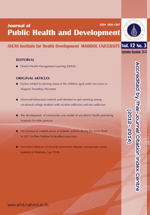Attitudes toward older adults among nursing students in a private university, Thailand
Main Article Content
Abstract
The research aimed to explore the nursing students’ attitude toward older adults and factors influencing
nursing students’ attitude toward older adults. The cross-sectional survey was designed to serve this purpose
192 questionnaires were distributed to all active nursing students who enrolled in the second semester of
the academic year 2013. The nursing students’ attitude toward older adults is assessed by Modified Kogan’s
Old People Scale (Modified KOPS) with its reliability tested by Cronbach’s alpha coefficient based on 20
nursing students and the value was 0.683. The Chi square test for independence were utilized for examining
factors influencing nursing students’ attitude toward older adults respectively.
A total of 151 questionnaires (78.65% has been returned), the mean value of Modified KOPS score
was at moderate level ( = 121.58, SD = 6.73). Age, religion and year of study were the significant
factors influencing nursing students’ attitude toward older adults. Furthermore, the Modified KOPS statement
analysis found that gender, nationality, and social interaction with older adult including having older adult
care experiences, living with older adults relatives, and being in a close relationship with an older adult in
the family were significant factors influencing nursing student’s attitudes toward older adults.
The research findings suggested that nursing students have the moderate level of attitude toward older
adults and the attitude of the nursing students have been progressively increased throughout their study
in this nursing program. Therefore, all nursing instructors must pay attention to conduct teaching-learning
activities to enhance students’ positive attitude toward older adult. It is critical that the nursing curriculum
must prepare essential knowledge in both theoretical and clinical aspects of gerontology in order to create
positive attitude toward older adults and consequently increase the quality of care improvement.






